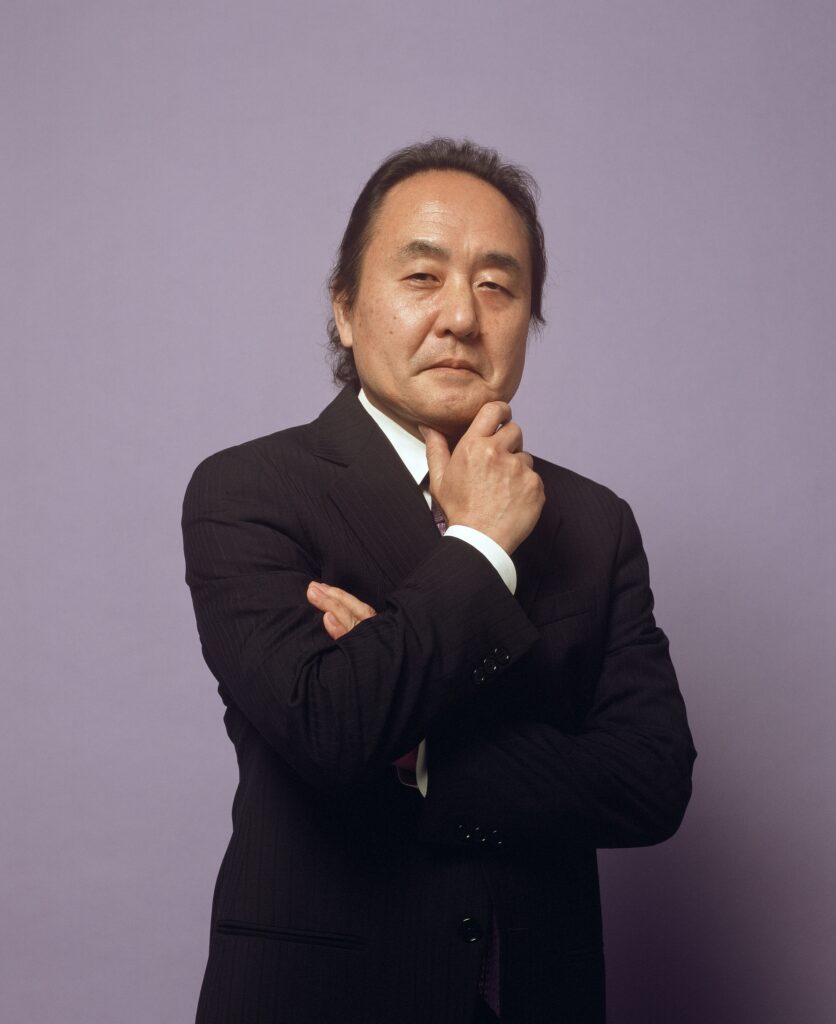
Ebihara Rogen
「書」の芸術性を鑑賞することは、筆で書かれた平⾯的な形や⽂字を⾒て、その意味や内容を理解することだけではない。「書」は、線質、潤渇、スピード感や強弱等の「線の表情」にも芸術性が宿り、まるで⾳楽を聴くように感じるインタラクティブな視覚芸術だと⾔われる。「書家は感情の変化を筆の動きで運び、読者はその“筆意”を読み取る」そう語るのは、書道家で墨アーティストの海⽼原露巌である。
彼の作品は、蓄積された⼈間観、世界観、⾃然観を捉えた「哲学」を体現する。彼の「書」は、「⾔葉」が持つ⼒の可能性を広げ、私たちが普段使う「⾔葉」の固定観念を真っ向から崩すエネルギーに満ち溢れている。
海⽼原は、1961年に栃⽊県の下野市で⽣まれた。幼少の時から書の才能に恵まれ、15歳の時に本格的に書の道へ進むこととなる。さらに、81年に⽇本書道⽂化使節団として中国に渡り、⻄安にある「碑林」と対⾯したことは、彼の書に対する信念を確固たるものとした。「碑林」には、顔真卿の顔⽒家廟碑や王羲之の集字聖教序といった歴代の名碑が収められており、書格・⾵格溢れる中国の歴史的な書法芸術を⽬の当たりにした彼は、そこで「書家としての道筋を決意した」と語る。
86年に有楽町マリオンで初個展を開催。中国・清時代の乾隆御墨や⽇本の古墨、⾃らが調合した墨を⽤い、古典に倣いながら書にもっともふさわしい⾊を探求している。92年、バチカン宮殿「謁⾒の間」にてローマ法王ヨハネ・パウロ2世に作品《翼》《蜂》を献呈。93年にNHKスペシャル『地の底への精霊歌〜炭鉱に⺠話の⽣まれる時〜』、NHK銀河テレビ⼩説『欅通りの⼈々』のタイトルを執筆。これまで映画や舞台、テレビドラマの題字や、CDジャケット、書籍などのアートワークも多く⼿がけている。94年の「墨アート−⾳楽を書す」にて書道パフォーマンスを⽇本初演。
2011年、中国蘇州・張家港市招待による鑑真和上記念式典に出席。書道パフォーマンスを披露し、同年に⻄安市の⼤興善寺でも書⽂化交流を⾏う。12年には⽂化庁より⽂化交流使に任命され、翌年にイタリアへ派遣される。作品は、カナダ歴史博物館、在フランス⽇本⼤使館、⼤明寺(中国)、陝⻄省歴史博物館(中国)、在⽇イタリア⼤使
館(東京)、ホテル雅叙園東京などに収蔵。そして18年に中国北京対外友好協会、⽇中和平友好条約締結40周年記念イベントにて、書道揮毫パフォーマンスを披露。20年、強羅花壇(神奈川・箱根)にて作品展「海⽼原露巌の墨の世界」、21年にはキンプトンホテル東京にて、ROGEN SUMIART 展 Time for Dreamingを開催。また「書巌の会」を主宰している。
海⽼原は「書」の芸術性やその概念の理解を⽇本や中国以外の海外でも深めていくため、グローバルな活動を熱⼼に⾏なっていることでも知られる。83年にはニューヨークに渡り、セントラルパークで⽑氈を広げて実験的にゲリラ的なパフォーマンスも⾏っている。今でこそ、TVタレントのように若者から⼈気を集める若⼿書家たちが、書のパフォーマンスを⾏なっているが、海⽼原がパフォーマンスをする書家としてのパイオニアであることは意外にも知られていないのではないだろうか。
海⽼原は現代アートにも取り組んでおり、その作品の特筆すべきところは、東洋的な要素と⻄洋的の要素の概念に捉われない美の創造性にあるところだ。彼⾃⾝もポール・セザンヌやジャクソン・ポロック、アントニ・タピエスといった⻄洋の画家たちからの影響を認めており、⻄洋的な空間概念をも吸収した⽂化的、美意識的に⾮常に厚みのある作品を創り上げている。「書」が東洋と⻄洋という⽂化の境界線を越え、芸術の架け橋になることが可能であることを⽰す書家としても、彼の右に出るものはいないだろう。
また、古典作品にも真摯に向き合うことで知られる海⽼原は、「古典をしっかり学ぶことで、書を書く時に迷いがなくなるようになる」と語る。しかし、その⽬的は「決して模倣ではない」と念を押す。古典を学ぶことは、古典の書の美しさの根源を解き明かし、歴史を超えて今に残る書の⼒の原理・法則を理解し、習得することである。そして、古典書の源流とその時代の美意識を取り⼊れることで、⾃分なりの書の解釈と⾃⼰のスタイルの確⽴が模索できるようになり、後世に残る作品を創り上げていくことが可能になるのだ。海⽼原は、それを使命として筆を揮い続けている。
「⼈⽣のなかで吸収してきたあらゆる⽂化や蓄積された造詣が、⼈々の共鳴を⽣み、芸術へのさらなる理解を育む」と、海⽼原は考える。⾰新性、精神性、古典的な優美さ、それらが⼀体となった彼の美学は、私たちを魅了してやまない。彼の作品が⽣み出される魔法のようなその瞬間に、より多くの⼈が⽴ち会えることを願うばかりだ。
Text by Akiko Yamanaka
Appreciating the artistry of ‘calligraphy’ is not only about looking at the flat forms and characters written with a brush and understanding their meaning and content.
Calligraphy is an interactive visual art in which the speed, curvature, moisture, strength and weakness and the texture of the lines themselves have their own artistic qualities. ‘The calligrapher carries the changes in emotion with the motion of the brush, and the reader reads the intention of the brushstrokes.’ This is how calligrapher and ink artist Rogen Ebihara describes calligraphy.
His work embodies a philosophy that captures his accumulated views of humanity, the world, and nature. His calligraphy is full of an energy that expands the possibilities of the power of words and breaks down the stereotypes associated with them. His calligraphy has also been described by critics as ‘having a three-dimensional grasp of the letter and sculpting space with his brush.’
In 1986, he held his first solo exhibition at the Yurakucho Marion; in 1992, he presented “Wings” and “Bees” to Pope John Paul II in the “Audience Hall” of the Vatican Palace; in 1993, he wrote the calligraphy title for the NHK TV documentary “Spirit Songs, to the Bottom of the Earth – Coal Mine Folktales” and NHK drama “People of Zelkova Street”. He has produced many artworks for movies, stage performances, TV dramas, CD jackets, books, etc.
In 1994, he gave a calligraphy performance for the first time in Japan at “Sumi Art – Calligraphy for Music” event, and in 2011, he attended the commemorative ceremony for the Buddhist monk Ganjin Wajo at the invitation of Zhangjiagang City in Suzhou, China. In 2012, he was also appointed by the Agency for Cultural Affairs of Japan to serve as a cultural ambassador to Italy, where he gave lectures and workshops at the University of Rome, the University of Milan, and the University of Venice, among other international and wide-ranging cultural exchanges.
His works are in the collections of the Canadian Museum of History, the Embassy of Japan in France, Daming Temple (China), Shaanxi Provincial Museum of History (China), the Embassy of Italy in Tokyo, and Hotel Gajoen Tokyo. In 2018, he gave a calligraphy performance at the Beijing Foreign Friendship Association in China and at an event commemorating the 40th anniversary of the conclusion of the Treaty of Peace and Friendship between China and Japan, and in 2020, he held an exhibition of his works, “The Sumi World of Rogen Ebihara” at Gora Kadan in Hakone, Kanagawa Prefecture. In 2021, the ROGEN SUMIART Exhibition “Time for Dreaming” was held at the Kimpton Hotel Tokyo. He also presides over the “Shogen no Kai” (Society of Calligraphers).
He is also working in a contemporary art context, and what is remarkable about his work is the sense of creative beauty that is not bounded by notions of Eastern or Western elements. Rogen says, ‘I believe that all the cultures and accumulated knowledge we have absorbed in our lives will resonate with people and foster a greater understanding of art,’ suggesting that it is possible to build artistic bridges across the cultural boundaries between East and West.
In particular, He is known for skillfully making use of even accidental elements such as ink, the conditions of the paper, and climate to create beautifully rendered calligraphy in pale gradations. The innovation, spirituality, and classical elegance are combined in Rogen’s aesthetic, and his artistry never ceases to fascinate us. We sincerely hope that more people will be able to be present at the enchanting moments when his work is created.
Text by Akiko Yamanaka